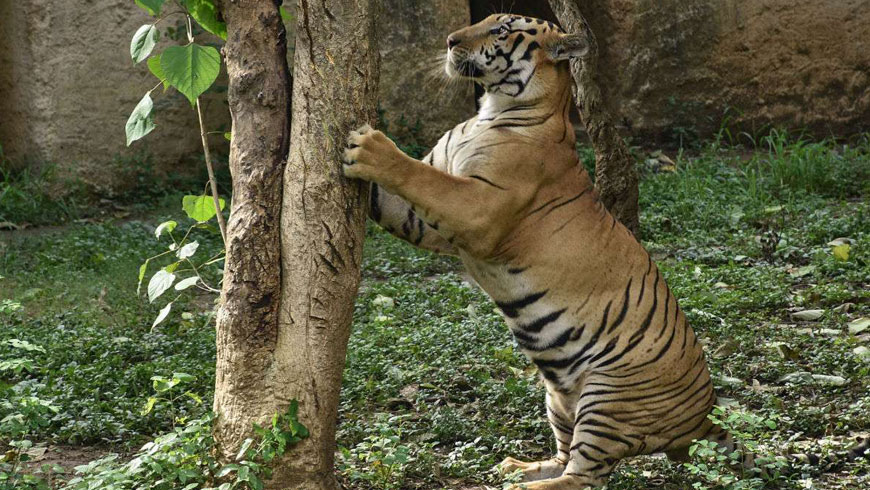The majestic Royal Bengal Tiger is present throughout India, excluding the Hot Deserts in the West and the Cold Deserts of the Trans-Himalayas in the North. It is a representation of power and prestige and has a rich cultural and historical connection with the natives of India.
A safari in India is a must-have experience for any Nature and Wildlife Traveler, as it is the only place on the planet where the majestic Tiger can be seen in its natural habitat. India currently has 50 Tiger Reserves with stringent Wildlife Laws and Protection, ensuring that the Tigers are safe and secure in their reserves.
In this article, we will examine some captivating details about the Royal Bengal Tiger and explore the modifications it has developed over thousands of years to become the top predator in the Indian Subcontinent.
The International Union for Conservation of Nature (IUCN) has classified this species as Endangered.
In 2018, India’s Tiger population officially amounted to 2967 (All-India Census). This is a significant increase since the 2014 All-India Tiger Census which revealed 2226 tigers living in the wild.
The survey data points to a rapid decline in the Bengal tiger’s habitat, which can only be attributed to a more effective counting technique and a wider area covered during the survey.
Praise is due to those who are combating poaching on the ground. However, the Indian authorities have not done enough to push up the threshold of Tigers in the country. As it stands, it is unlikely that the current number of Tigers will increase.
Adjustments Made to the Tiger
The tiger is an animal that has undergone a number of modifications to adapt to its environment. These changes have enabled it to survive in a range of habitats, from jungles to grasslands. The tiger’s adaptations include its size, strength, speed, camouflage, and hunting techniques. Its size helps it to overpower and capture prey, while its strength allows it to climb, swim, and run long distances. Its speed allows it to chase down and catch its prey, while its camouflage helps it to remain hidden from potential predators. Finally, its hunting techniques, such as stalking and ambushing, help it to successfully capture its prey.
The Royal Bengal Tiger’s orange coat and black stripes aid in obscuring its movements as it strides through the jungle, with its hue becoming almost one with the sunlight that radiates through the leaves. This camouflage also works well while stalking prey in the grasslands.
- The vibrissae of a Bengal Tiger are like additional sensory organs, permitting them to detect the movement of other creatures and their presence.
- Much like other Vertebrates, the Bengal tiger possesses an Olfactory Gland, called the Jacobson’s organ, which is located near the palate in the mouth and can detect the presence of other tigers from clues such as urine, scat, and smell.
- The retractable claws of a Royal Bengal Tiger help keep them sharp and allow them to be used only when necessary.
- The Royal Bengal Tiger has a wide space between its Molars and Canines, which gives it the advantage when trying to strangle its target.
- The Jaw Muscles of the Royal Bengal Tiger are linked directly to the top of their craniums and the Lower Jaw is able to only move vertically and not horizontally, thus providing them with the capability to secure their tight grip on the prey in their possession.
- The Royal Bengal Tiger has an immense head and a formidable set of jaws, which allows it to make a lethal strike on prey that are much heavier and bigger than it.
The delicate and tender Fur on the Paws of the Bengal Tiger enables them to move around in the jungle without making any loud noises.
- The Royal Bengal Tiger is distinctively equipped with lengthy hind legs that give them the strength to make large leaps, some up to thirty feet in a single bound.
The Conduct of the Tiger
The actions and mannerisms of the tiger can have a great effect on its environment. Its behavioural patterns can significantly change the dynamics of its habitat. Tigers are known to be extremely predatory and have a tendency to hunt down their prey. They also have a territorial instinct, which means they will defend their territory against intruders. Furthermore, tigers are extremely social animals and prefer to live in groups. They are also known to be very intelligent, which allows them to adapt to new surroundings quickly.
- Tigers are solitary creatures, and the only occasions when a group of them can be seen is when a mother is present with her young offspring or a male and female are in courtship. Occasionally, an entire family of tigers may be spotted when the male takes a break from his territory patrol to visit his cubs.
- Instances of Tigresses raising two distinct generations of cubs have been recorded, with one set on the brink of dispersal and the other being newborns. This behavior has been noted in particular at the Pench National Park in India.
- The Home Range of a Male Royal Bengal Tiger typically spans between 50-150 sq km, and they are known to fiercely protect their area from any rival males, including their own adult male progeny.
In the Males’ Area, there may be a couple of Female Tigers, usually 2-4, with whom mating occurs occasionally to generate progeny.
Hunting on their own can be a taxing effort of both time and energy; however, they have no qualms about taking advantage of other animals’ kills.
- It is estimated that 7 in 10 hunting attempts by a Bengal Tiger will be unsuccessful, so it is best if the tiger is within 30 feet of its target to increase the chances of success.
Ungulates’ sharp senses of hearing and smell and Primates’ vigilant eyes can be a big hindrance to Tigers in the pursuit of their prey due to the fact that they can sound an alarm to protect themselves from harm.
The Tiger is an incredibly aware creature, developed to hunt and it relies on its strength and knowledge to take down its larger prey.
The Sambar and Nilgai, both large animals, can provide sustenance to a Tiger for up to two days. In these intervals, the big cat can consume up to 20 kilograms of meat per day.
Courting
Courting is a process in which two people show an interest in one another for the purpose of starting a romantic relationship. It typically involves various forms of communication such as wooing, flirting, and expressing interest. It can involve activities such as going on dates, sending gifts, and expressing admiration.
- Bengal Tigers do not have a particular period of the year when they reproduce.
When a Female Royal Bengal Tiger is in heat and prepared to breed, she leaves indications in the shape of Scent Markings or Sprays on noticeable trees which may be in the course of a Male Bengal Tiger. These urinal sprays have a strong odor and contain pheromones which the Male Tiger can detect by smelling it and utilizing its Jacobson’s Organ to interpret these chemical signals from it.
- In the attempt to draw the attention of a nearby Male Tiger, a Tigress may vocalize with a roar that can be heard as far as 4 km away by another Tiger.
- On occasion, these indicators can lead to disputes between a number of males vying for attention, which in turn can cause battles. These altercations may sometimes be fatal.
- Therefore, the female is able to choose the strongest hereditary material to pass onto her young.
- Though it is not always the case, a Male Tiger may intrude and kill the cubs of a female if she is unable to protect them. This is done in order to get the female to quickly enter estrous, so that he can mate with her.
- A Female Bengal Tiger may attempt to “falsely-mate” with an interloping Male Tiger if she can lead him away from where her cubs are so as to appease him. She will stay with him until the potential threat has passed.
A Male and Female Bengal Tiger typically stay together for several days, mating frequently in order to conceive.
- Although the science behind successful conception is a mystery, it has been noticed that certain Female Tigers do not get pregnant, despite numerous sightings of them mating. This may be the result of various causes, such as lack of appropriate habitat, tension, and rivalry with other Tigers.
The Parental Role of a Tiger
Tigers are majestic animals that have been known to carry out a parental role in the wild. They take care of their young, teaching them skills that are essential for survival. Mothers in particular, spend a lot of time with their cubs, protecting them and helping them learn.
- The duration of pregnancy typically ranges from 100 to 115 days.
The number of cubs per litter typically varies from two to five, though rarely five may be born at once. Unfortunately, not all of them typically survive. There is one instance in which all five cubs were raised to adulthood: a Wild Tiger that lives in Pench National Park. More information about this extraordinary creature can be found here.
For approximately five months, cubs are nourished with their mother’s milk, after which they are able to be weaned successfully.
- The Female Tiger is tasked with the difficult job of raising her cubs on her own and hunting successfully while keeping them well-concealed during the journey. Unfortunately, the cubs are in a vulnerable state and therefore very prone to danger, leading to a large mortality rate.
- A Tigress may take refuge in the crevices of large rocks or the trunks of toppled trees as a hideaway.
- As they mature, the cubs follow their mother around her territory, gathering knowledge and honing their abilities. Eventually, she will take them on hunts too, where they will witness her skilful stalking of prey without making her presence known. The larger the cubs are, the more frequently she will be expected to hunt.
- A Female Tiger will hunt and wound her prey, but she refrains from delivering the final blow. She then provides her cubs with the injured animal, allowing them to gain the experience of ending its life. The cubs must learn to remove the fur and pull the flesh apart, though the process may seem gruesome. Nevertheless, this is an essential ability needed for the Tiger to survive.
When cubs reach the age of 18-22 months, their mother gradually stops providing them with food and becomes more aggressive. This marks the end of their dependence on her and they are now required to start fending for themselves. A life of solitude awaits them as they strive to survive and form their own territories. It is hoped that they would have mastered the art of hunting by this stage.
- Compared to their female counterparts, male sub-adults tend to disperse at an earlier age, and often traverse greater distances to set up their own territory.
Different Varieties of the Tiger Found Globally
- Nine distinct varieties of Tiger exist across the globe.
- Of the nine species, three have become extinct in the wild, with a fourth appearing highly likely to have done the same.
The Internet has become an integral part of our lives, enabling us to access information and communicate with others in ways we never thought possible. It has revolutionised the way we interact with each other, providing us with an unprecedented level of connectivity. We can now access data and communicate with people from anywhere in the world in a matter of seconds. The Internet has truly revolutionised the way we live our lives.















